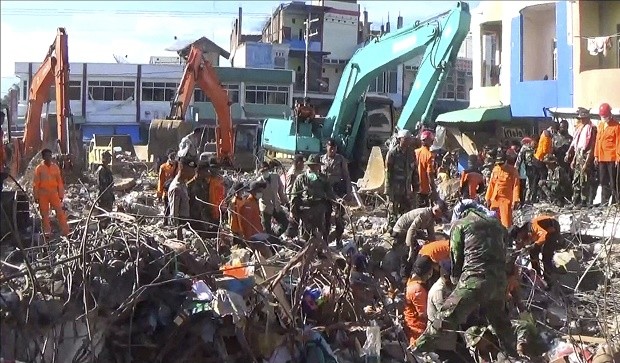
In this image made from video, rescuers use excavators to search for victims in the rubble of collapsed buildings following an earthquake in Pidie, Aceh province, Indonesia, Thursday, Dec. 8, 2016. Humanitarian organizations descended on Indonesia’s Aceh province Thursday as the government in Jakarta promised tons of emergency aid and officials raced to assess the full extent of damage from an earthquake that killed more than 100 people. AP
MEUREUDU, Indonesia — Humanitarian organizations descended on Indonesia’s Aceh province Thursday as the government in Jakarta promised tons of emergency aid and officials raced to assess the full extent of damage from an earthquake that killed more than 100 people.
Search efforts involving volunteers and nearly 1,500 rescue personnel were concentrated on the hard-hit town of Meureudu in Pidie Jaya district near the epicenter of the magnitude 6.5 quake that hit before dawn Wednesday. Humanitarian assessment teams were fanning out to other areas of the district.
READ: Strong 6.4-magnitude quake hits off Indonesia — USGS
National Disaster Mitigation Agency spokesman Sutopo Purwo Nugroho said the death toll had risen to 102 and warned it could increase. Search teams were using devices that detect mobile phone signals with a 100-meter (yard) radius to help guide their efforts as they scoured the rubble, he said. Aceh’s disaster mitigation agency said more than 600 people were injured.
Thousands of people are homeless or afraid to return to their homes. Aceh officials said more than 8,000 people spent Wednesday night in shelters in Pidie Jaya district alone.
Killer quakes occur regularly in the region, where many live with the terrifying memory of a giant Dec. 26, 2004, earthquake that struck off Sumatra. The magnitude 9.1 quake triggered a devastating tsunami that killed more than 100,000 Acehnese.
The Indonesian government said its urgent aid would be flown out of Jakarta early Thursday afternoon and will include 10 generators, tents, folding beds, baby supplies and body bags.
The military is setting up an emergency field hospital and sending two dozen doctors, and the Health Ministry is deploying a medical team and sending medicines. The Red Cross sent aid such as water trucks on Wednesday and humanitarian group CARE is leading an assessment team of four international aid groups to avoid duplication of efforts.
“Every aid and civil society organization is piling into the area with as many boxes of rice, instant noodles, blankets and other aid as they can shift,” said Paul Dillon, a spokesman for the International Organization for Migration, which has an assessment team in northern Aceh.
It will take at least two more days before there’s a fuller picture of how many people are displaced and the relief effort required, he said.
The U.S. Geological Survey said the earthquake was centered about 19 kilometers (12 miles) southeast of Sigli, a town near the northern tip of Sumatra, at a depth of 17 kilometers (11 miles). The agency had initially placed the epicenter undersea. It did not generate a tsunami. As of 9 a.m. Thursday, some 36 aftershocks had rattled the area.
The world’s largest archipelago, Indonesia is prone to earthquakes due to its location on the Pacific “Ring of Fire,” an arc of volcanoes and fault lines in the Pacific Basin. The 2004 quake and tsunami killed a total of 230,000 people in a dozen countries, most of them in Aceh.
John Ebel, professor of earth and environmental sciences at Boston College, said there is a risk that even weak aftershocks could cause further damage to buildings, particularly because modern building codes aren’t consistently enforced in Indonesia.
Scores of rescuers were crawling over a market in Meureudu, the hard-hit town, where many shop houses collapsed.
One shop owner, Hajj Yusri Abdullah, didn’t hold out much hope of finding survivors. He said nearly two dozen bodies were pulled from the market debris the day before. They included a group of eight made up of a newlywed couple and family members holding an ornate celebration known as Antar Dara Baro.
Siti Rukiah, a mother of four, was among the many people who took refuge for the night in local mosques. She and about 100 other people from Pante Raja, a seaside village, fled to Nur Abdullah Mosque located on higher ground in a nearby hamlet.
She said the quake felt so powerful she had to grab onto a table to keep from falling down. She was sure a tsunami was coming.
“I’m really scared about a tsunami,” said Rukiah, whose brother and neighbors died in the 2004 disaster. She said she didn’t want to return home “not only because my house is damaged, but I am still afraid an aftershock could cause a tsunami.”
The national disaster agency said nearly 600 buildings were severely damaged or destroyed in the districts of Pidie Jaya, Pidie and Bireun. Most were shop houses or dwellings but mosques, a hospital, boarding schools and a shopping center also sustained damage. Roads also cracked and power poles toppled over./rga